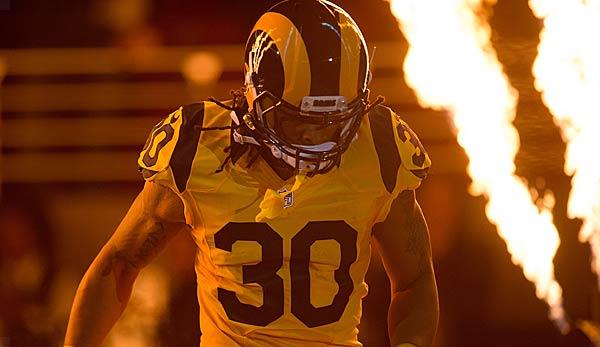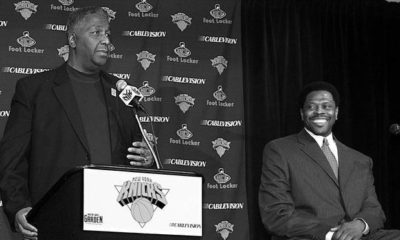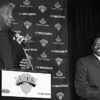US-Sport
NFL: Third and Long: The 2017 season was an anomaly
You want to ask questions to the SPOX-NFL column? This goes directly to the author!
Passing dominates, for a good play-action pass game you need a good run game, the base defense doesn’t deserve its name anymore, short pass offenses dominate – so many stat- and storylines are at the end of an NFL season, through which you first have to work.
Which trends are right? Which are conspicuous and possibly already signposts for the future? These are the questions addressed in today’s Third and Long column. And you’ll notice: In some aspects, the 2017 season can be described as an anomaly compared to the past years.
A narrative that everyone hears over and over again: Passing dominates everything. With regard to the outcome of games – i.e. the meaning – this is also correct, the passing game is much more important. Quantitatively, however, the past season was a striking anomaly, after years of constant trends.
Passing yards per game were at their lowest level since 2010 (224.4 yards – in comparison: 241.5 yards per game in 2016). Teams reached a new first down 11.6 times per match over the pass. Here, too, you have to go back to 2010 to find a lower value.
The average runs per game per team, on the other hand, had never fallen below 27 until 2011. Then a constant decline took place. Until last season.
There were also four teams with over 30 runs per game for the first time since 2014:
The rushing yards per game have been very stable since 2013 (4.2 – 4.2 – 4.1 – 4.2 – 4.1).
On the other hand, efficiency in terms of space gain also declined in 2017 in the passing game. The net yards per pass, into which sacks are included, have risen almost constantly since 2005, from 5.9 to 6.4. In 2017 there was a decline of more than 0.2 yards, the net yards per pass fell to 6.1. There had been a decrease of 0.3 yards from 1972 to 1973 (5.7 to 5.3).
The Adjusted Net Yards per Pass, which includes not only sacks but also interceptions and touchdown passes – one of the most comprehensive pass statistics – confirm this trend: Quarterbacks 2017 (5.9 – 2016: 6.2) were at their lowest value since 2013, the Yards per Reception (11.3) were even at their lowest value since 2007 and consequently the Yards per Play (5.3) were also at their lowest value since 2010.
What does that tell you? It shows to some extent a return to a more conservative approach. At 1st&10 teams still ran in 53 percent (!) of the cases last season.
The formations also reveal a lot here, because for the first time in years the use of 11-personnel (i.e. three wide receivers, one tight end, one running back) is on the decline in percentage terms: from 2011 to 2016 this number had risen constantly from 40 to 60 percent, in the past season it fell to 59 percent for the first time. And this is not due to spread offenses, as the 4 receiver sets actually declined from 2016 to 2017. Therefore 13-personnel (one RB, three HP) went up.
There are two obvious explanations: firstly, the attempt to capitalize on “lighter” defense fronts. According to Pro Football Focus, the proportion of games with five or more defensive backs climbed from 43.4 to 63.4 percent from 2008 to 2015, and has since stabilized in this area.
The constellations still called sub-packages are the actual new base defense, the third cornerback (or for some teams the third safety) are more of a starter than one of the linebackers. This makes the defense stronger against the pass, but physical disadvantages can occur against the run. The almost through the bank away noticeable increases in the use of the Run Game are a potential answer to this and one can already expect a reaction of the Defenses – for example by 3-Safety packages – in 2018.
The other explanatory approach concerns the quarterback situation. Of the four teams with over 30 runs per game, the Jaguars and Bills tried to take as much as possible off the shoulders of their quarterbacks. With the Vikings this was also true at least in moderation after the Bradford injury, while with Carolina the quarterback is an elementary part of the run game.
And this list can be continued: In the other top 10 runs per game, the Colts, Broncos and Ravens were three other teams that tried to “hide” their quarterback in 2017. The cowboys (rank 5) are also strongly focused on the run game and the rams (rank 9) have also helped Jared Goff via the run game in addition to their passing designs.
The above decrease in the number of yards per reception and the (Adjusted) Net Yards per pass has other reasons: The short pass opening dominates the picture in the NFL, and on a grand scale.
This shows, on the one hand, the massive percentage of passes flying no further than ten yards.
Figures from ESPN and Inside the Pylon. Quarterbacks are sorted by percentage passes in the 1-10 yard range.
In addition to this: Five quarterbacks with at least 225 attempts to pass have thrown a total of 70 percent of their passes ten yards or shorter: Josh McCown (73.6%), Aaron Rodgers (73.1%), Alex Smith (72.2%), Drew Brees (71.5%) and Brett Hundley (70.9%). No quarterback with over 200 passes has thrown less than ten percent of them in front of the line of scrimmage.
Screens and short passes are the preferred means of choice: quarterbacks got the ball away in 2.67 seconds on average in recent years, from 2011 to 2013 it was still 2.77 seconds. This makes Interior-Pressure even more important, because defenders have the quicker way to the quarterback. Interior pressure has a greater effect on the offense than edge pressure anyway.
And further: While in 2016 there were 14 quarterbacks with at least 200 passes on over 9.5 intended air yards per pass (i.e. how far they throw the ball on average), last season only eight quarterbacks with at least 200 passes reached this value.
Only three quarterbacks were in the top 10 in both years: Ben Roethlisberger (2016: 9.9/2017:9.5), Carson Palmer (10.2/9.7) and Jameis Winston (10.8/10.7). And Arizona’s Downfield-Offense is a reliable supplier of stats: In the pre-season all three Cardinals quarterbacks – Drew Stanton (10.8), Palmer and Blaine Gabbert (9.5) – were in the top 10, even though Stanton (159 passes) and Gabbert (171) do not count for my evaluation listed above.
Another statistic confirming this trend: in 2016, 19 quarterbacks (again: minimum 200 passes) tossed on average up to or further than the first-down marker. In 2017, this number dropped to 12 QBs.
Summary to date: Teams are becoming more conservative, whether in the purely numerical use of the run game or also in the way in which their own passing game is developed. The short pass game determines the thinking here and helps to conceal the blatant O-Line problems faced by so many teams.
Another stylistic means for this is at the latest since the Super Bowl triumph of the Eagles everyone should be familiar with are the Run Pass Options. Philly used the RPOs in 207 games including the playoffs, more than any other team. Philadelphia also led the regular season with 181 RPOs, ahead of Kansas City (168) and Green Bay (143).
The league average was 63, Baltimore came last with only eleven run pass options played – and the league-wide completion percentage for run pass options was 78 percent in 2017. By comparison, the total passing completion average for 2017 was 62.1 percent, also the lowest value since 2013, and RPOs can be expected to play an even greater role in the coming season.
The second option besides RPOs to help the quarterback significantly is the good old play-action passing game – which is still inexplicably neglected by teams (Raiders, I’m looking in your direction). The successes are obvious, and I recommend this pro-football-focus analysis on the subject.
This shows, among other things, that over the last three years almost every quarterback (at least 850 passes) has recorded an increase in its register rating with Play Action. The only exceptions: Aaron Rodgers (whose register rating without Play Action over this period is already so high that the difference to Play Action is simply very small), Derek Carr, Ben Roethlisberger and Joe Flacco.
Football Outsiders has also evaluated the play action figures from 2011 to 2017, and it is clear that teams have almost two full yards more (8.2 vs. 6.4) per play at 1st&10 compared to other passes. The discrepancy is not quite as high in other game situations, but in general, play-action passes almost achieve larger space wins through the bank away. Except 3rd&3-10, where the yards per play number is identical.
The latter is a good transition to another central point: important for a good play-action-pass game is not the run game itself – decisive are the game situation, the practice of the fake and the unpredictability of the own formation. In long third down situations, the threat from the run game – regardless of how good the run game is – is less tactically, simply because a run game move is less likely. That’s why Play Action is less efficient here.
The large discrepancy at 1st&10, on the other hand, shows: Defenses expect a run more often here, are most likely in their base formation (as shown above by the running moves on this down). Not surprisingly, the Play Action Pass game is most successful (8.3 yards per play) at 1st&10 with the quarterback under center.
The quality of your own run game, on the other hand, has no effect on the quality of the play action game. There is no statistical correlation between the yards per run and the yards per play action pass. The PFF study shows that even bad rushing teams (teams with less than 3.5 yards per run) see the same increase in the register rating for normal vs. play action passes.
The Patriots have their finger on the pulse once again: According to the PFF, New England had the best play action register rating (131.6) in 2016 and promptly threw Tom Brady a total of 151 play action passes in 2017, more than any other quarterback in a season over the past three years. If we assume that run pass options will play a bigger role, then the drastic successes of Case Keenum and Marcus Mariota teams should also inspire the defense to make life even harder through more play action.
Page 1: Run Game, Passing Game, Play Action – 2017 as an anomaly?
Page 2: Overrated players, quarterbacks, steelers – your questions


















You must be logged in to post a comment Login